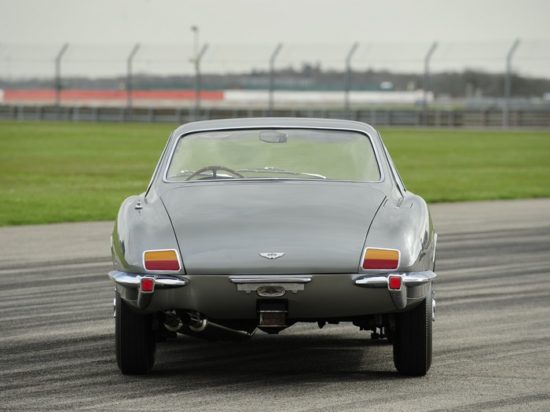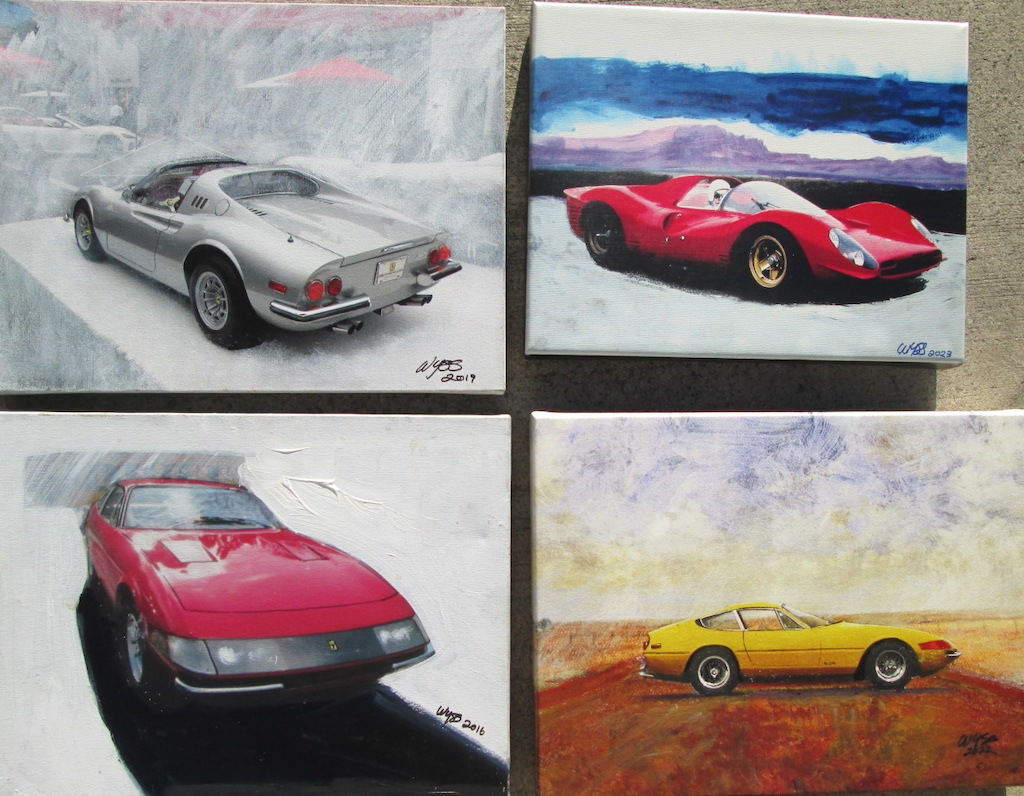This 1960 Aston Martin DB4 GT Bertone Jet Coupe – a sleeper saved…
by Wallace Wyss –
Sometimes it’s the odd one that appreciates the most… At one time, race cars were fetching a lot more at the major auctions than car show one-offs. The idea was that if you buy a race car, if you’re lucky you get one with history. You buy a show car, a one-off what do you get? A momentary bauble. A flavor of the moment as it were. Designs that came and went, mostly forgotten.
Well this 1960 Aston Martin DB4 GT Bertone Jet coupe, chassis 0201L, Engine no. 370/-201/GT was sold at a May 2013 Bonhams auction for the top dollar sum of 3,249,500 GBP ($4,928,697 USD) which is more than some Aston Martin DB4GT race cars go for even with some racing history.
There is a reason for this. This particular car was the last DB4 GT chassis—and the last of any series is worth more than the ones in the middle.
First a little bit about the Aston Martin DB4 GT as a model. “DB” means “David Brown” by the way, he being the owner of Aston after WWII. The DB4GT was introduced as the competition version of the DB4 sports saloon. First launched in 1958, the Aston Martin DB4 was a direct challenge to Ferrari. It had an all new steel platform chassis with disc brakes all round, and a race-developed twin-cam six-cylinder 3.7-litre engine, all clothed in a perfectly proportioned aluminum body designed by Touring Superleggera of Milan.
Engineered by Harold Beech, the immensely strong platform-type chassis had Touring’s Superleggera body which used a lightweight tubular structure to support hand-formed aluminum body panels. The front suspension employed unequal-length wishbones while the rear was live axle located by Watts linkage.
But the factory quickly realized they needed a lightweight version for racing, that model, the DB4GT, making its debut at the 1959 London Motor Show. The lightweights had 5 inches chopped out of the wheelbase and replaced the rear seats with a luggage platform on all but a small number of cars. Even the bodywork was thinner aluminum, which contributed to 200 lb (91kg) less weight than in the street model.
On this Comp version, it had a few changes from the touring car, such as faired-in headlamps with Perspex covers, a feature later made standard on the DB5 and DB6. The rear screen and quarter windows were Perspex (Plexiglas) on many examples; bumper over-riders were deleted and the wind-down windows were frame-less within the doors. Twin Monza quick-fill competition fuel fillers were added atop the rear fenders, and a large-capacity fuel tank mounted flat in the boot. GTs were fitted as standard with lightweight Borrani 42-spoke wire wheels with alloy rims and three-ear ‘knock-offs’.
Piloted by the likes of Roy Salvadori, Stirling Moss, Jim Clark and Innes Ireland, the DB4GT model did well. Only 30 were produced in left-hand drive configuration. The Aston Martin DB4GT was another variant, bodied in Italy by Zagato and those have become the most sought after of the DB4GT cars.
This particular car, chassis 0201L, was ordered by Bertone to be the carrozzeria’s show car for the 1961 Geneva Motor Show. The design Giugiaro had put on paper wasn’t just a bolt-on, the whole wheelbase had to be shortened five inches. The body that went on was steel even though someone somewhere is saying it was 200 lbs. lighter than the aluminum-bodied production car (possible, when you consider the weight savings of cutting out five inches of length.)
The car did its time at the auto show where it was celebrated (though some seem to think the Giugiaro-designed Bertone-bodied split grille Ferrari 250GT SWB coupe a more memorable design, done the same year.)
The engine was tweaked a bit, still an inline six twin-cam displacing 3.7-liters but producing 302 bhp (225 kW) at 6,000 rpm as a result of switching to three Webers, a sizable jump from the standard 240 bhp (179 kW) output. The car would go 0-60 mph in 6.1 seconds and top end was 153 mph.
Upstaged by the Jaguar E-Type
One reason the Jet coupe did not get much publicity at the time it was first shown was because it had the misfortune of being unveiled in 1961 at the Geneva show just as Jaguar rolled out the E-type, which was arguably a very seductive shape at less than a third the price of an Aston Martin. So the press sung the praises of the Jag and the Aston was ignored. Timing is everything.
And then the Aston disappeared into the sands of time. Some say it was in Beirut. Then it went to America where it didn’t fare too well. An engine fire scorched the bonnet and engine compartment and then, through poor storage, the body actually rusted because the body was made of steel, not aluminum.
The Rescue
Who should rescue it? None other than the Chairman of Aston Martin at the time, Victor Gauntlett. He brought it back to Blighty, and had his shop re-do it, which involved much rust repair and hand fabrication of various one-off bits.
The car was midway through restoration when Hans-Peter Weidmann discovered it and bought it in 1988 and the car was finished for him. He drove it quite a bit, accumulating 35,000 miles, one time telling OCTANE magazine that he did 950 miles in one day across the U.S. and part of Canada (surpassing the author’s own epic trip of 750 miles in one day but I am sure Hans-Peter was driving a car considerably more entertaining).
When Weidmann passed on, the family brought it to Bonhams in 2013, who fetched that extraordinary amount.
Your author feels the outsize amount, more than some DB4GTZ cars were selling for at the time, was due to the fact that it is an example of “early Giugiaro”, i.e. the work of then young designer Giorgetto Giugiaro, who toiled at the boards at Bertone while still in his 20s, creating a surfeit of memorable designs. Other one-off Giugiaro cars like the Maserati Boomerang, have also fetched large amounts because they are one-offs that were well remembered show cars.
Lesson to be learned here? One-off show cars, however obscure, can be good long range bets. That’s because a lot of those scrambling to buy a factory race car –particularly a Zagato-bodied DB4GTZ – walked right on by this show car, figuring it just to be a show car bauble. Also in this case Giugiaro was becoming ever more famous, and is now recognized as the most brilliant designer of the Sixties to come out of Italy. Lesson No. 2: Buying a car that has had a fire sounds scary but the truth is that there are fires and there are fires. Maybe the fire in this was confined to the engine compartment. True, some of the small trim parts were irreplaceable, which means you can get them made again but it’s going to cost an arm and a leg. But if it sold for several million, one could be fairly sure there was enough profit in there to re-make all the little parts that had to be fabricated.
Now it’s possible the general public wouldn’t have known about this car sitting in obscurity, but it’s logical that all news funneled to the man at the top, helped by the fact that Gauntlet was reportedly a true car nut and Aston enthusiast.
Apparently many knew of the car sitting around in America, in the back of some shop but not one enthusiast who saw it was willing to tackle a car that was an edition of one, with no spare body parts and a blackened lump under the bonnet. Ironically, though, after finding it and starting the restoration, Gauntlett let it go half finished to an enthusiast.
Not only did Hans-Peter buy it but it sounds like he had a helluva lot of fun with it. I envy first his “eye” for recognizing the car’s pedigree and then the fun he had in driving a one-off Giugiaro grand touring creation built on such a great race-bred platform. He drove it further than most any barn find purebred I’ve heard of. I would venture to say he got full use of it (take that, you fellows who are scared to take your classic car out for fear of “road rash”).
Lesson learned here? Don’t pass up those “ugly ducklings” – the one-offs that people pass up on their way to pay full boot for a race car with history. Sometimes the “ugly duckling” grows more beautiful in time, as this Aston certainly did.
In 2013 it set a record price for an Aston Martin automobile at auction, selling for $4.9 million. That tops the previous record price of $4.6 million, paid for an original James Bond Aston Martin DB5 at an RM sale in 2010, but not quite as high as the $14,300,000 paid at a 2015 RM Sotheby’s auction for an Aston Martin DB4 GT Zagato. All far below the ultimate Aston–the 1959 LeMans winning DBR1 piloted by cowpoke/car builder Carroll Shelby and Roy Salvadori supposedly for sale at $32 million.
Let us know what you think in the Comments.
THE AUTHOR: Author of 18 car histories Wyss is now wielding a paintbrush, depicting his favorite classics in oil on canvas. He will be manning his Art & Books booth at Concorso Italiano.










Although I am a big fan of Bertone and Giugiaro – from the front it reminds me of a Karmann Ghia and from the rear it looks like a Lamborghini 350GT.
I like the original AM DB4 GT better.